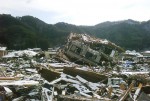Why Does the Likelihood of Terrorism Increase After Natural Disasters?
 Photo: DFID
Photo: DFID In a new RAND working paper, authors Claude Berrebi and Jordan Ostwald use international data to argue that countries which experience a major natural disaster are more likely to have an increase in terrorism activity afterward. In the abstract they write:
…Using a structured methodology and detailed data on terrorism, disasters, and other relevant controls for 167 countries between 1970 and 2007, we find a strong positive impact of disaster-related deaths on subsequent terrorism deaths and incidence. We find that, on average, an increase in deaths from natural disasters of 25,000 leads to an increase in the following year of approximately 33 percent in the number of deaths from terrorism, an increase of approximately 22 percent in the number of terrorist attacks, and an increase of approximately 16 percent in the number wounded in terrorist attacks, holding all other factors constant.
The authors use examples from Asia to South America and make clear that the terrorism/disaster link is not limited to one type of disaster or one area of the world. Typhoons in the Philippines can disrupt a society’s politics much like a flood in Pakistan. However, certain types of disasters seem to create a higher level of terror than others. They write: “In particular, geophysical and hydrological disasters prompt a more sustained and escalating effect on terrorism than climatologic or meteorological disasters.”
Before everyone starts yelling about correlation and causation, the authors explain that natural disasters do not cause terrorism in and of themselves. After a disaster, a government must redirect its resources to cleaning up and rebuilding. This leaves them more vulnerable than they would otherwise be, and terrorists usually prefer “soft” targets. In the clean-up process, money and resources are often given to the least-vulnerable parts of the country in efforts to rebuild, which often greatly angers the most vulnerable. Natural disasters, then, reveal pre-existing fractures that are easily exploited by terrorists. The authors make an almost poetic parallel when they write:
It is said that terrorism does not arise in a vacuum (Shughart 2006). Similarly, natural disasters are not, in and of themselves, defined by the physical shocks which induce them. A large earthquake, far from human civilization, may be felt only by a few individuals inhabiting that area and is not likely to constitute a disaster. Pre-existing vulnerabilities, both political and societal, largely determine the extent to which an environmental shock induces destruction
Perhaps one could go so far as to say that it’s the combination of heavy development and lack of infrastructure in third world countries that makes natural disaster damage that much worse and the likelihood of terrorism that much greater.

Comments